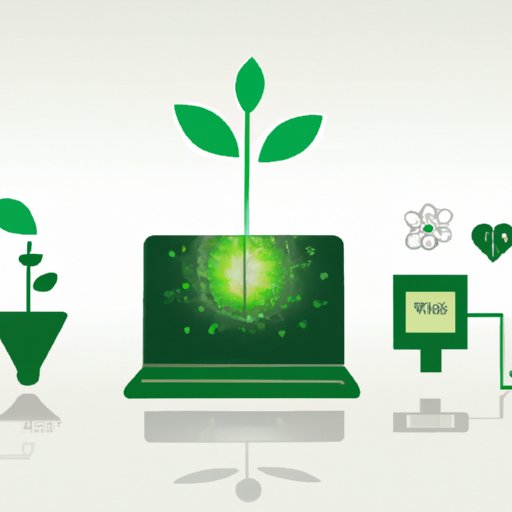Introduction
Green information technology (IT) is a term used to describe the use of IT systems and technologies to reduce energy consumption and increase sustainability. The goal of green IT is to reduce the environmental impact of IT systems while also reducing costs and improving operational efficiency. As organizations become increasingly aware of their environmental responsibilities, the use of green IT is becoming more prevalent.
In this article, we explore the greatest benefit of green information technology. We examine the economic, environmental and organizational impacts of green IT, as well as the role it plays in data security. By understanding the full range of benefits associated with green IT, organizations can make informed decisions about how to best leverage these technologies to meet their goals.

Exploring the Economic Benefits of Green Information Technology
One of the primary benefits of green IT is cost savings from energy efficiency. According to a study conducted by IBM, an organization that adopts green IT strategies can save up to 50% on energy costs over a three-year period. This cost savings can be attributed to the fact that green IT technologies are designed to be more energy efficient than traditional IT systems. For example, cloud computing allows for the consolidation of server resources, which reduces the amount of energy consumed by individual servers.
In addition to energy savings, green IT can also help organizations reduce maintenance costs. Traditional IT systems require regular maintenance and upgrades, which can be costly. However, green IT systems are designed to be more reliable, meaning they require less maintenance and fewer upgrades. This can result in significant cost savings over time.
Finally, green IT can improve organizational productivity. According to a study conducted by Gartner, organizations that implement green IT strategies experience improved employee satisfaction and increased productivity. This is because green IT systems are designed to be more user-friendly and efficient, which makes them easier to use and more efficient than traditional IT systems.

Examining How Green IT Enhances Sustainability
In addition to economic benefits, green IT can also help organizations enhance their sustainability efforts. One of the primary ways green IT does this is by reducing carbon emissions. According to a study conducted by the Carbon Trust, the use of green IT can reduce carbon emissions by up to 40%. This reduction is due to the fact that green IT systems use less energy, resulting in lower emissions.
Green IT can also help organizations improve resource management. By leveraging technologies such as virtualization and cloud computing, organizations can better utilize existing resources, resulting in fewer wasted resources. In addition, green IT can help organizations reduce waste by eliminating paper documents and using digital document storage instead.
Finally, green IT can provide organizations with increased recycling opportunities. By utilizing technologies such as e-waste recycling, organizations can reduce the amount of waste they generate and ensure that any waste they do produce is recycled properly.
Investigating the Environmental Impact of Green IT
The use of green IT can also have a positive impact on the environment. One of the primary ways green IT does this is by reducing pollution. By utilizing technologies such as solar energy and energy-efficient lighting, organizations can decrease their reliance on traditional energy sources, resulting in lower emissions of pollutants into the atmosphere.
Green IT can also help organizations decrease their over-consumption of resources. By utilizing technologies such as virtualization, organizations can better manage existing resources and reduce their need to purchase new ones. This can help organizations reduce their overall consumption of resources, resulting in a smaller environmental footprint.
Finally, green IT can provide organizations with increased recycling opportunities. By utilizing technologies such as e-waste recycling, organizations can reduce the amount of waste they generate and ensure that any waste they do produce is recycled properly.

Analyzing the Impact of Green IT on Organizational Performance
In addition to its environmental benefits, green IT can also have a positive impact on organizational performance. One of the primary ways green IT does this is by improving employee morale. According to a study conducted by the Institute of Electrical and Electronics Engineers, employees who work in green IT environments experience higher job satisfaction and greater engagement with their work. This is because green IT systems are designed to be more user-friendly and efficient, making them easier to use and more enjoyable to work with.
Green IT can also help organizations enhance their customer relationships. By utilizing technologies such as video conferencing and digital document storage, organizations can provide customers with more convenient and efficient services, resulting in improved customer satisfaction.
Finally, green IT can help organizations increase brand loyalty. By demonstrating their commitment to sustainability, organizations can build trust with their customers, resulting in increased loyalty and repeat business.
Understanding the Role of Green IT in Data Security
Finally, green IT can also play a key role in data security. By utilizing technologies such as encryption and authentication, organizations can ensure that sensitive data is secure and accessible only to authorized users. This can help organizations protect customer data and comply with regulations such as the General Data Protection Regulation (GDPR).
In addition, green IT can improve the accessibility of data. By utilizing technologies such as cloud computing, organizations can ensure that data is available to authorized users at all times, regardless of location or device.
Conclusion
In conclusion, green information technology provides organizations with a wide range of benefits. From cost savings to improved sustainability and data security, green IT can help organizations achieve their goals while also reducing their environmental impact. To fully realize the benefits of green IT, organizations should consider implementing green IT strategies such as energy efficiency, virtualization and cloud computing.
(Note: Is this article not meeting your expectations? Do you have knowledge or insights to share? Unlock new opportunities and expand your reach by joining our authors team. Click Registration to join us and share your expertise with our readers.)
